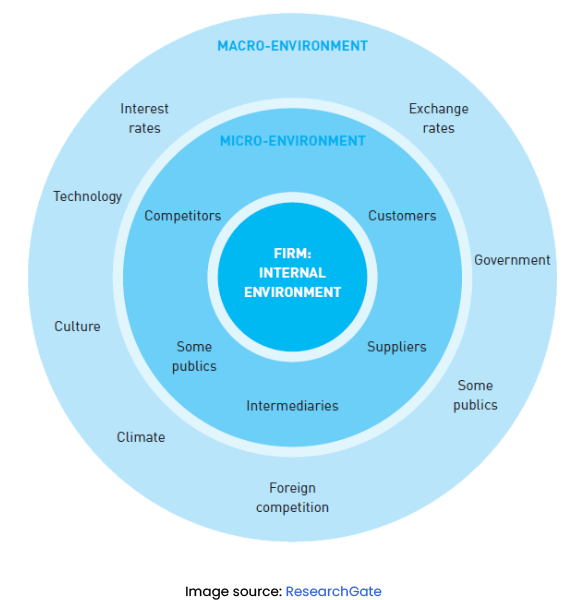
Click the button to start reading
Your Micro Environment in Marketing: What Are the Key Elements for Success
In this fast-paced world, knowing your marketing environment isn’t just important. It’s essential for survival.
Customers’ preferences change. Competitors use new strategies. And trends emerge like waves on the shore. To succeed, you need to be the captain of your micro environment – the place where immediate influences matter the most.
So let’s delve into the key elements that make up the micro environment in marketing. You’ll learn how these elements shape the marketing outcomes. What’s more, you’ll get real-world examples of companies that handle their micro environment successfully.
What Is a Micro Environment in Marketing?

The micro environment in marketing is the small world that directly influences your company. And it’s the world that’s within your control. It includes customers, competitors, suppliers, distributors, and other important people or groups.
Imagine yourself as a shop owner in a bustling market. You have a front-row seat to observe customers, competitors, and suppliers in action. Success in this micro market means understanding customer needs and offering unique products.
But don’t forget, there’s a larger world beyond the market—a whole city that influences your business. This is the macro environment, encompassing the economy, government regulations, and cultural trends. While you can’t directly control these factors, they still impact your business. To thrive, you must adapt your strategies to the changing cityscape.
So, in the world of marketing, it’s important to pay attention to both the micro and macro environments. Only by having this full understanding can you create a thriving business.

Five Elements of the Micro-Marketing Environment
Understanding and managing the key players in the micro environment helps you in many ways. First, you can understand your customers and reach them through the right channels. Second, you can stand out from competitors. And finally, you can maintain good relationships with suppliers and intermediaries.
Below are the key actors in a micro-marketing environment. Plus, real-world examples to put everything into context.
Customers: Powering Success
These are the people or companies who buy or use your products or services. It’s important to understand how they behave, when they buy things, and what they like. Obviously, this helps you create effective marketing campaigns and customer acquisition strategies.
But there is more. Nowadays, it’s not about the product or service alone. Customers care about having enjoyable experiences when engaging with businesses.
By the way, a whopping 88% of customers believe that the experience a company offers is crucial. In fact, as crucial as its products or services!
Example
Apple Inc. has lots of fans who can’t wait to get their hands on the newest iPhones and MacBooks. Apple listens carefully to what customers like and how they behave. Then, they use this information to make amazing products that people really want. When Apple designs products that match what customers want, it leads to lots of happy customers who keep coming back for more.
Competitors: Driving Innovation
Looking for ways to stand out? It’s crucial to know what your competitors are doing.
These are the other companies that sell similar products or services in the same market. It’s important to figure out what they’re good at and what they’re not so good at. This helps you find ways to be better and stand out.
Example
Coca-Cola and PepsiCo are fierce competitors in the beverage industry. They keep a close eye on each other’s marketing tricks and new product releases. For example, do you know what happened when PepsiCo launched its healthier product line (PepsiCo)? Well, Coca-Cola responded without a delay. It added low-sugar and diet drinks to keep up with the changing trends and preferences.
Suppliers: Essential Partnerships
To make products and run your business, you need materials and resources. And that’s where suppliers come in. They’re the helpful friends who provide the necessary things to make your products. If you have good relationships with them, you can get what’s needed on time and at a good price.
Example
Here’s another example of mastering the micro environment in marketing.
Nike is a global leader in the sportswear industry. And it relies on suppliers to provide high-quality materials for their shoes and apparel. Nike works closely with its suppliers to make sure they always have the best stuff. Also, they care about responsible production. So they collaborate on finding sustainable ways to get the materials.
Intermediaries: Vital Connectors
Intermediaries are the middlemen or middle companies that help you get your products to customers. They might be wholesalers, retailers, or distributors. Working well with them is important for getting products to customers efficiently.
Besides, it’s important to make sure they understand your products so they can sell them effectively. Why? Because they influence how products are priced, promoted, and made available to customers. Usually, intermediaries work in the background. They ensure that products are available in stores, online platforms, or other places where customers can find and buy them.
So, think of marketing intermediaries in the micro environment as important teammates. They help you reach customers and make sure products are available when people want them.
Example
Next, let’s take Walmart and Procter & Gamble (P&G) as an example. You can buy lots of different things at Walmart, including products made by P&G.
Walmart is what we call an intermediary or middleman. They help P&G get their products to customers. They put P&G’s products on their shelves, both in their physical stores and online. This way, customers can easily find and buy the products they need.
Surely, it’s a win-win situation where both P&G and Walmart help each other succeed in the market.
Internal Stakeholders: Decision Makers
The micro environment in marketing would be at a loss without internal stakeholders. These are the people within a company who have a say in marketing decisions. They can include top management, employees, and shareholders. Getting everyone on the same page, of course, is important for successful marketing.
Example
Let’s take Microsoft. Here, the top management, the employees, and the shareholders are the decision-makers. So, the top bosses provide direction. The employees bring the marketing plans to life. And the shareholders give support to ensure the company’s success.
To do well in marketing, all these internal stakeholders should be on the same page. When they work together, they can design effective plans and create great experiences for customers. It’s a team effort where everyone plays a part in managing the micro environment.

How Do Macro Factors Shape Your Company’s Micro Environment?
Your micro-marketing environment doesn’t exist in isolation. Let’s explore how the bigger factors can shape your company’s immediate surroundings:
Firstly, economic conditions have a big impact. If the economy isn’t doing well, people are spending less money. So it affects customer demand, pricing, and market conditions in the micro environment.
Next, technological advancements are important. Exciting new technologies can emerge, and you may need to adopt them to stay competitive. Otherwise, you have to find new ways to reach customers in the micro environment.
Sociocultural factors matter too. Changes in society’s values, attitudes, or trends can impact what customers want. For instance, once people become more concerned about sustainability, it influences their preferences. In the micro environment, marketing teams have to study how customers behave and what they like. In the end, they use this information to create go-to-market strategies that appeal to the right people.
Finally, political and legal factors are also influential. Government laws and regulations can impact how you operate in your micro environment. For example, new rules related to advertising, labeling, or data protection may force you to adjust your practices.
Boost Your Micro Marketing Environment with a Project Management Tool
What if you can transform your micro environment with the help of Teamly, a robust project management tool? To begin, Teamly will help you set clear goals and track progress. Next, you can break down tasks and collaborate seamlessly with your team. What’s more, the visual timelines will help you stay ahead of important milestones. With Teamly, you can level up your efficiency and achieve remarkable results.
Final Thoughts
Marketing success depends on grasping every aspect of the micro environment in marketing. And it’s a journey we undertake as a team. Although marketers lead the way, all departments play a part in embracing these elements.
Remember, your strength lies in teamwork. Collaboration, insights sharing, and aligned efforts unlock a panoramic view. Together, you can adapt, innovate, and outpace the competition!
















